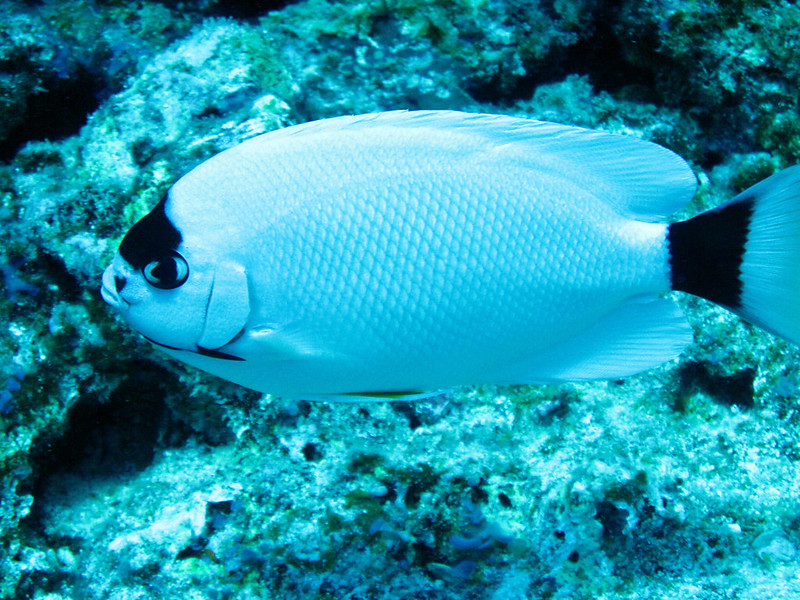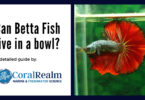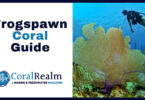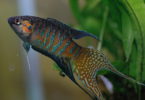Last Updated on November 19, 2022 by Matt
The Masked Angelfish, Genicanthus personatus, is a species of marine angelfish of the family Pomacanthidae, endemic to the Hawaiian Islands. They are very rare with only one or two caught a year, if that, which has driven up the price to ridiculous amounts! Although Genicanthus personatus has now been successfully bred in captivity.
In this masked angelfish care guide, we will run through everything you need to know about how to successfully keep and care for these amazing fish.
| Masked Angelfish Summary | |
| Care Level | Advanced |
| Family | Pomacanthidae |
| Temperament | Not usually aggressive |
| Diet | Omnivore |
| Origin | Hawaii, Midway Islands |
| Minimum Tank Size | 150 gallons |
| Color | Black and white or black, white and yellow |
| Size | Up to 8.3 inches |
| Reef Compatible? | Yes |
| Temperature | 70℉ – 75℉ (21℃ – 24℃) |
| Specific Gravity | 1.020-1.026 |
| pH Range | 8.0 – 8.5 |
IN THIS ARTICLE
Description
The masked angelfish, scientifically known as Genicanthus personatus, is an extremely rare deepwater angelfish. This fish is one of the most wanted aquarium fish throughout the aquarium trade, mainly due to how little it is seen. The masked angelfish used to be virtually impossible to obtain as it was living in the deep depths of the ocean; however over the years it has become slightly more attainable through captive breeding programmes. This fish is now available to purchase, if you have the money to spend; this species of fish costs between $10,000 – $20,000. If you have one of these fish in your aquarium, you will certainly turn heads!
They are a member of the Genicanthus genus, and the marine angelfish Pomacanthidae family. The Pomacanthidae family contains seven genera and about 86 species, which includes the Queensland Yellowtail Angelfish, and while visually similar shouldn’t be confused with freshwater angelfish, which are cichlids of the Amazon Basin.
This reef fish is as beautiful as it is expensive, with a pure white body and a thick stripe going over its eyes.
Being protogynous hermaphrodites, these masked angelfish actually start off their life as a female, and turn into males later on in life. These fish are also sexually dichromatic, meaning that their colorings are different for males and females. Adult females usually have a white body with a black tail and yellow pelvic fins. As the female gets older, any black patches on her body become smaller and usually result in small black patches around the eyes, lips and gills.
They become males once they hit 6-7 inches in size. The males’ pectoral fins, face and the edge of their dorsal fins are bright yellow/orange in color. However they still hold the black tail fin. Males will also develop filamentous extensions to the caudal fin.
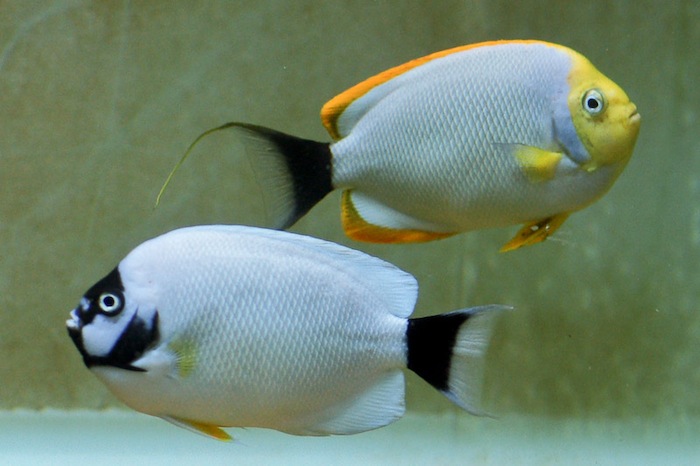
Adult male and female masked angelfish, clearly showing the difference in coloration. Credit: Chung Wing Hung
Distribution
The masked angelfish is native to Hawaii and can be found in various areas along the Pacific Ocean island chain, it mainly inhabits great depths around the Hawaiian islands. These fish prefer cooler waters, proved by their movements between depths depending on the temperature of the water in that area, so they are only found around 100 – 570 feet underneath the water, the first masked angelfish was discovered in 1972 near Waikiki.
The masked angelfish is found at shallower depths as they reach the Northwestern Hawaiian Islands, they can sometimes be spotted in depths of less than 100 feet in Pearle and Hermes reef.
Genicanthus personatus Behavior and Diet
In the wild, masked angelfish are active swimmers that love to explore and forage, so it is important for this to be encouraged in captivity, mainly by giving them a large, open aquarium. In their natural environment inhabiting the seas of Hawaii, these fish are rarely sighted, so their behavioral habits are still being found and researched. However, male masked angelfish have been sighted turning grey in color; this is used to signal to cleaner fish that they are a safe fish and can be cleaned by removing parasites and dead tissue.
Masked angelfish are omnivores that eat both animal and plant matter in the wild, they’ll often eat clams, shrimp, benthic macroalgae, detritus, crustaceans, fish larvae and fish scales. In captivity, they can be offered a range of pellets, live food and frozen food. Small algae pellets are a good way of providing them with a source of plant matter, however they will forage around the tank and consume plant and algae debris. Live and frozen food will provide these fish with the nutrients they need, good options are brine shrimp, small clams and worms. They can be fed everyday in small portions.
Aquarium set up
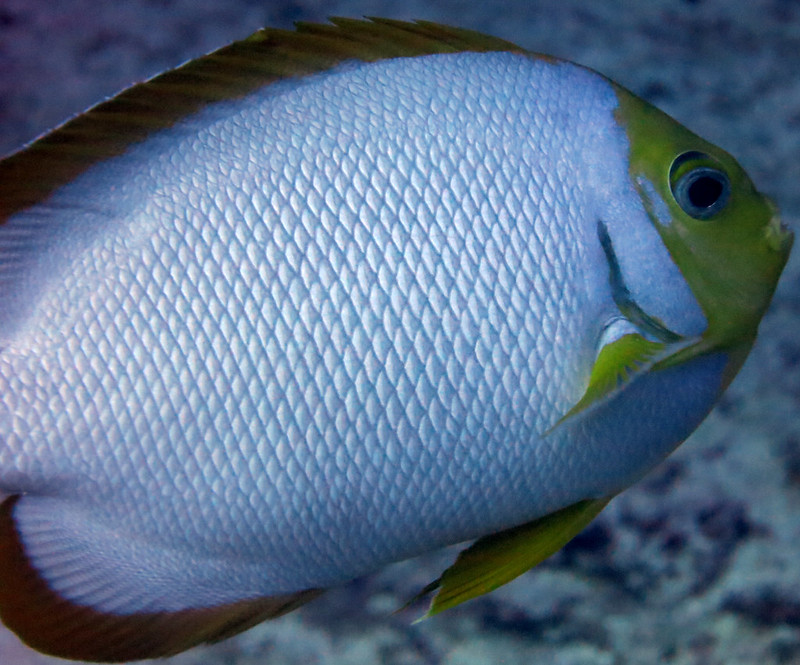
Credit: NOAA Photo Library (Flickr)
Masked angelfish are reef compatible and would live happily in a peaceful community reef aquarium. As they are active swimmers and foragers, as well as their large adult size, they need to be kept in a large aquarium of 150 gallons at a bare minimum. When housing them in a reef aquarium we would suggest monitoring them around coral as they may try and nip at the coral when foraging, but they will not go out of their way to eat or destroy the coral.
Cleaning the sides of the glass regularly will remove algae and debris build up from the surface, this is a great way to maintain the cleanliness of the tank and also ensure that the masked angelfish can be seen properly and their bright colors can show through the glass.
Masked angelfish need the water temperature to stay in the range of 70 – 75℉, and so an aquarium heater and thermometer are needed to maintain this. A carbonate hardness of 8-12 dKH and a pH range of 8.0 – 8.5 will simulate the natural environment.
Masked Angelfish Tank Mates
Masked angelfish are relatively peaceful and will not be aggressive without being bothered by another fish. They are best housed in a species only tank or with other peaceful community fish. They are normally kept in a mixed species tank either alone or with one other masked angelfish, due to their enormously high price; it is very rare that one person is housing a large group of these fish.
We recommend to stay away from any aggressive and fin nipping fish, as they will harass these fish and cause unnecessary stress. Also avoid any small shrimp or other invertebrates as they will most likely become food. Other small fish may also be a source of food for this angelfish once it grows big enough, so we suggest sticking to medium – large sized fish.
If you are keeping these fish in a group, it is recommended to have one male per three or four females.
Conclusion
To sum up, this rare expensive species is definitely one to be proud of when keeping them. Their bold colors and active behaviors make a great statement in a large aquarium, this beautiful fish will certainly be a showstopper in any aquarium.
Provided you give them the care they much deserve, they will be the perfect asset to a display aquarium, only if you can afford to get your hands on one. These fish are rare to see in the open ocean, so having one in your home is certainly an achievement.
Featured Image Credit: NOAA Photo Library (Flickr)

